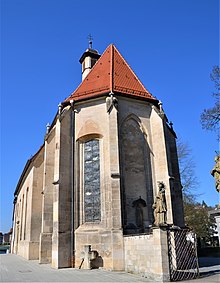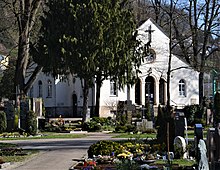St. Leonhard (Schwäbisch Gmünd)
St. Leonhard is a cemetery complex east of the old town of Schwäbisch Gmünd , between the Bundesstrasse 29 and the Remsbahn , consisting of the Gothic Leonhard Church (also Leonhard's Chapel ), the post-Gothic Herrgottsruhkapelle and the Leonhard Cemetery .
Leonhard's Church
The oldest written mention of the Leonhardskirche is from the summer of 1345. At that time the current church already existed. The roof of the choir is dated to 1340/41, the roof of the nave only to 1471, although this is due to a renovation during this time. An assumption that was often expressed and, among others, by Hermann Kissling through the analysis of stonemasons ' marks, supported the assumption that the master builder family Parler , who also built the Gmünder Münster, built the chapel, could not be proven or refuted. Overall, the new construction of the Leonhard Cemetery with such a large cemetery church is viewed as astonishing, because at the same time a chapel with cemetery, the Michael Chapel, was built next to the new minster. In the years 1776 to 1779 the church was extensively redesigned in Baroque style by the city architect Johann Michael Keller . The plastering work was done by Laurentin Hieber from Neresheim , the paintings were done by Joseph Wannenmacher . In 1779 a sacristy was added, in 1782 the sacristan's house on the west facade, which gave the Leonhard Church its characteristic appearance.
In 1907 and 1916, as well as in the 1970s, major renovation and restoration work took place. The last major renovation was carried out from 1997 to 1999. Today the Leonhardskirche, which belongs to the parish of St. Franziskus, serves mainly as a cemetery chapel for the Leonhard Cemetery, which, along with the Trinity Cemetery, is one of the two remaining city cemeteries and is characterized, among other things, by its old tree population.
After the bell of the Leonhardskirche had failed at the funeral of the city music director Dietmar Spiller in 2012 , the dilapidation of the roof ridge became known. In 2018, extensive renovation, in particular of the roof area, began. In August 2018, the bells were removed and also sent for repair.
Herrgottsruhkapelle
The Herrgottsruhkapelle was built by Kaspar Vogt in 1622 instead of a previous chapel , which was first mentioned in 1495 . The chapel, built in the post-Gothic style , was changed several times, for example the nave was rebuilt in 1692 and a sacristy a hundred years later in 1792. In 1839 the chapel was sold to the merchant Xaver Deibele, who always tried to hold masses on working days, although the church council in Stuttgart spoke out against them. From 1894 to 1898 the chapel was renovated through donations. In 1924 the chapel returned to the church. In 1978 it was given to the Alt-Gmünd working group. In 1983 the chapel was renovated again outside and from 1988 to 1990 inside. The Old Catholics have been using the chapel since 1990 . It is also used by the Peter Brotherhood for Sunday worship.
From 2012 to 2014, the chapel was extensively renovated on the outside at the end of the conversion work into the Gmünder Einhorn Tunnel .
The Herrgottsruhkapelle served as a model in 1677 for the St. Josef's Chapel , located southwest of the old town .
Leonhard Cemetery
In the early days of Schwäbisch Gmünd, the city's cemeteries were around the Gmünder Münster and the Johanniskirche as well as by the monasteries. The earliest surviving evidence of a burial at St. Leonhard comes from 1477, although it is assumed that the cemetery outside the city walls was associated with the larger new construction of the cathedral and the loss of space on the cathedral square . In the year of the plague in 1542 it was enlarged for the first time, followed by another in 1622. When the inner-city cemeteries were abandoned in 1804, St. Leonhard was initially the only cemetery, which is why another expansion was necessary in 1830 and redesign and expansion between 1859 and 1864. After the Second World War , the capacity was no longer sufficient, so the Trinity Cemetery was opened southeast of the city, which is now significantly larger than St. Leonhard.
Personalities buried near St. Leonhard
- Johannes Buhl (1804–1882), businessman, gymnastics pioneer and fire department pioneer.
- Johann Baptist Bommas (1816-1893), composer and Catholic priest (burial site dissolved; last attested in 1959)
- Anton Pfitzer (1818–1892), parish priest and local researcher
- Julius Erhard (1820–1898), manufacturer and collector
- Adolph Untersee (1842–1893), Lord Mayor of the city and member of the state parliament
- Bruno Klaus (1848–1915), teacher, politician and local researcher
- Paul Möhler (1852–1929), center politician and Lord Mayor of the city
- Karl Haußmann (1860–1940), surveyor, geomagnetist and university professor
- Josef Bidlingmaier (1870–1967), watch manufacturer
- Alfred Boppel (1872–1951), photographer
- Walter Klein (1877–1952), Rector of the Higher Technical College for the Precious Metals Industry Schwäbisch Gmünd and local researcher
- Hermann Erhard (1883–1968), manufacturer and politician
- Albert Deibele (1889–1972), pedagogue, local researcher and city archivist of Schwäbisch Gmünd
- Fritz Möhler (1896–1978), goldsmith and professor at the higher technical college for the precious metal industry in Schwäbisch Gmünd
- Hans Hirner (1906–2004), businessman, President of the German Chamber of Commerce for Spain
- Josef Janota (1911–1994), politician
- Gebhard Luiz (1913–2013), Catholic pastor
- Erich Ganzenmüller (1914–1983), educator and politician
- Alfred Lutz (1919–2013), graphic designer, university professor and prorector of the HfG Schwäbisch Gmünd
- Peter Spranger (1926–2013), historian, educator, headmaster of the Scheffold-Gymnasium Schwäbisch Gmünd
- Max Seiz (1927–2020), sculptor
- Peter C. Schenk (1928–2020), architect and university professor
- Norbert Schoch (1932–2008), lawyer and mayor of the city
- Walter Giers (1937–2016), light, sound and media artist
- Hans Kloss (1938–2018), painter and graphic artist
literature
- Josef Seehofer: The cemetery chapel of St. Leonhard in Schwäbisch Gmünd (= Gmünder Hefte, local history series, Volume 8). City Archives Schwäbisch Gmünd , 1969.
- Albert Deibele , Hermann Kissling : St. Leonhard in Schwäbisch Gmünd and the care associated with it. History and list of documents, files, etc. Volumes with an appendix on the Trinity Chapel and St. Salvator. 1323 to the present . Schwäbisch Gmünd: City Archives 1971 ( online ).
- Richard Strobel: The art monuments in Baden-Württemberg. City of Schwäbisch Gmünd, Volume II: Churches in the old town without the Holy Cross Cathedral . Deutscher Kunstverlag, Munich / Berlin 1995 ISBN 3-422-00569-2 .
- Theo Zanek: Death and its graveyard. The Leonhard Cemetery in Schwäbisch Gmünd . In: Einhorn-Jahrbuch Schwäbisch Gmünd 2000, ISBN 3-927654-84-1 , pp. 163–170.
- Johannes Schüle: When stones speak. Grave monuments in the cemetery near St. Leonhard in Schwäbisch Gmünd . Published by the Schwäbisch Gmünd City Archives [with a foreword by David Schnur]. Schwäbisch Gmünd 2019 ISBN 9783981367591
- Hans-Helmut Dieterich: The St. Leonhards Chapel and the cemetery there in Schwäbisch Gmünd. Extended edition with a description of the Herrgottsruh Chapel from 1622. Schwäbisch Gmünd 2017, ISBN 978-3-9813675-7-7 .
Web links
Individual evidence
- ↑ St. Leonhardskirche: Extensive renovation , article from May 29, 2018 in the Rems-Zeitung .
- ↑ Leonhardskirche: Bells removed , article from August 24, 2018 in the Rems newspaper.
- ↑ Article Hergottsruhkapelle in fresh splendor from September 9, 2014 on remszeitung.de .
Coordinates: 48 ° 48 ′ 10.7 " N , 9 ° 48 ′ 17.2" E








